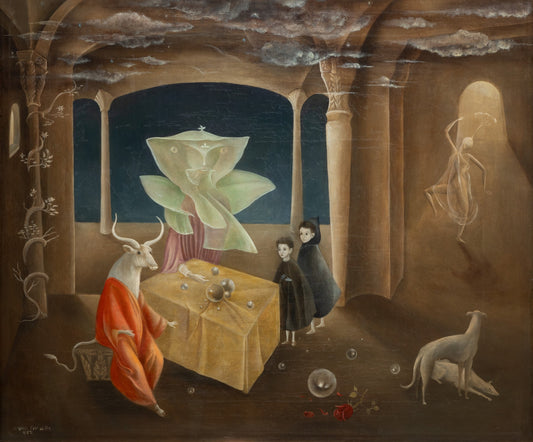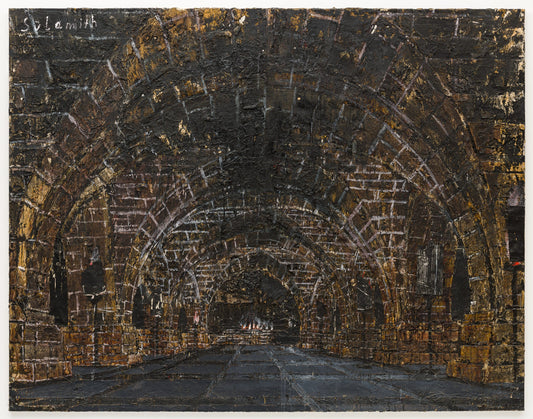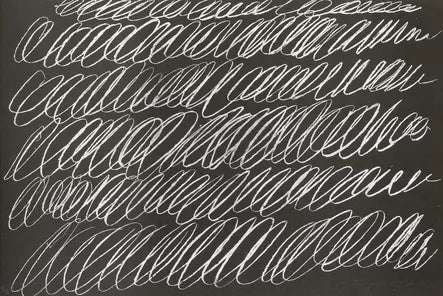Why Does The Internet Love The Two-Thousand Yard Stare?
The Two-Thousand Yard Stare, a visceral illustration showcasing the devastating emotional toll of war, has been used in memes for over a decade. The circumstances behind the illustration as a piece of wartime art and its accompanying psychological distress may give some insight into why people love humorously using the image, helping them process everyday emotions and situations through art depicting our world's reality.
The Two-Thousand Yard Stare (1944)

Sometimes referred to as Marines Call It That 2,000 Yard Stare or That 2,000 Yard Stare, The Two-Thousand Yard Stare is a 1944 illustration by war artist Thomas C. Lea III, first published in a 1945 issue of Life magazine. It depicts a worn-down Marine amid the Battle of Peleliu during World War II. The soldier looks on with sunken eyes and a piercing, cold, vacant stare that reaches somewhere beyond the viewer. Behind the soldier, chaos unfolds as smoke rises from the landscape and bombers fly overhead, with other tired soldiers wounded from battle lingering in the background.
Lea said about the anonymous Marine, the illustration's subject, “I noticed a tattered Marine staring stiffly at nothing. His mind had crumbled in battle. His eyes were like two black empty holes in his head. [...] He left the States 31 months ago. He was wounded in his first campaign. He has had tropical diseases. He half-sleeps at night and gouges Japs [sic] out of holes all day. Two-thirds of his company has been killed or wounded. He will return to attack this morning. How much can a human being endure?”
The Battle of Peleliu, which lasted from September 15, 1944, to November 27, 1944, resulted in over 6,500 casualties within the 1st Marines Division. The fate of the Marine featured in The Two-Thousand Yard Stare is unknown.
What is known, though, is the psychological symptom the Marine in Lea’s illustration is experiencing. The phrase “2,000-yard stare,” as the title refers to it, or more commonly, the 1,000-yard stare, is generally used to describe the “blank, unfocused gaze of people experiencing dissociation due to acute stress or traumatic events.”

While first associated with combat veterans as a symptom of “shellshock,” the 2,000-yard stare is better defined today thanks to advances in mental health care. The unfocused or dissociated gaze linked to the 2,000-yard stare can occur in anyone during a stressful or traumatic situation—not just veterans of combat. The 2,000-yard stare is a common symptom of Post-Traumatic Stress Disorder (PTSD), the diagnosis that evolved from initial observations of battle-fatigued and shell-shocked soldiers.
An article from Hektoen International, a journal of medical humanities, notes just how impactful the Battle of Peleliu was on those who fought: “Victims of that battle, with ongoing PTSD, included the Marines and Japanese who bitterly fought there, the corpsmen and physicians who treated their wounds, and the artist who painted the struggle.”
Thomas “Tom” C. Lea III
Thomas “Tom” C. Lea III, the artist behind The Two-Thousand Yard Stare, was born in El Paso, Texas, on July 11, 1907. He attended the Art Institute of Chicago from 1924 to 1926, then was an apprentice under Chicago-based muralist John W. Norton from 1927 to 1932. In 1944, became a combat correspondent in the western Pacific for the U.S. 1st Marine Division during WWII, where he painted his accounts of the horrors he witnessed. In addition to The Two Thousand Yard Stare, Lea’s work The Price also showcases the graphic, disabling nature of the injuries WWII soldiers faced. Lea recalled his service as a correspondent: "My work there consisted of trying to keep from getting killed and trying to memorize what I saw and felt."

Outside of combat correspondence, Lea had a prolific career. Known for paintings featuring the sweeping landscapes of Texas and northern Mexico, Lea was a favorite artist of former President George W. Bush. Upon his election, President Bush borrowed Lea’s painting Rio Grande from the El Paso Museum of Art and displayed it in the Oval Office.
Lea died on January 29, 2001.
The role of a war artist
Today, when almost everyone has access to a high-quality camera through their phones, the concept of a war artist may seem outdated. What exactly is the role a war artist plays in times of conflict?
Commissioned by the government, by a publication, or self-motivated, a war artist is tasked with documenting first-hand experiences of war and battle in an illustrative style. In the U.S., war artists have been a part of the military since 1917. American war artists were often deployed during World War I, World War II, and Vietnam. Only three American war artists were deployed during the early years of the War in Afghanistan in the early 2000s.

Even with advances in and greater technological access, war art has a personal touch that differs from war photography and descriptions. Although the role has become somewhat rare in recent conflicts, similar areas of war correspondence, like war photography and journalism, also seek to document the harsh realities and human cost of conflict. War artists undoubtedly paved the way for citizen journalists and laypeople alike to take to social media to document the happenings of current devastating conflicts occurring in countries like Ukraine and Palestine.
Wartime artists and photographers, alongside journalists, are especially important amidst Western government-backed atrocities in which mainstream corporate media outlets suppress and distort the realities on the ground. The current genocide in Palestine has seen scores of courageous photojournalists and artists manage to get images, videos, and stories out to the rest of the world through apps like TikTok. These heroes and their families have been systematically targeted and killed as a result of their bravery.
History as a meme
On a lighter note, The Two-Thousand Yard Stare has been used by Internet denizens in memes, jokes, and parodies for much longer than some might expect. Its first documented use in memes was on October 11, 2014, from a Reddit user who created a Photoshop edit from the original painting. Its use continued in informal Photoshop contests on Reddit’s r/photoshopbattles community from 2014 to 2015, according to Know Your Meme . Many would Photoshop or completely recreate their own version of the painting to include characters from pop culture who bore a similar expression to the soldier in the original.

The Two-Thousand Yard Stare began to take off and spread to social media communities outside of Reddit in the early 2020s. On X (formerly Twitter), users in late 2022 and early 2023 used The Two-Thousand Yard Stare as a “me when”-type reaction image. The soldier’s hollow, tired gaze is meant to emphasize whatever caption the poster has included with the image—usually, the caption presents a situation of distress or “intense trauma.” One example includes the caption, “When that one song you love more than yourself reaches TikTok.” Similar examples have been posted on TikTok. On the Internet, memes and trends come and go very quickly. But 80 years after it was first created, The Two-Thousand Yard Stare has remained a go-to reaction image for some time.
Why do people love it?
People might love using The Two Thousand Yard Stare in memes for many reasons. Using a dark, striking image or situation for comedic purposes is common among memes and other forms of Internet humor. Gen-Z, an entire generation of young people who’ve grown up with the Internet, are particularly known for their self-deprecating humor online. The serious nature of the image might compel people to compare their own experiences to something as drastically traumatic and emotionally taxing as a war battle. With mental health diagnoses steadily increasing among young people, this raw depiction of PTSD may connect with those who also suffer from similar symptoms of dissociation.
Additionally, The Two-Thousand Yard Stare is far from the first time the Internet has co-opted pieces of historical artwork for use in memes. Medieval art is a staple of memes due to its distinct “ugly” style, making works from this period fodder for endless amounts of humorous posts. Norman Rockwell’s piece Freedom of Speech (1943) also rose to popularity in the early 2020s, using it as a reaction image as The Two-Thousand Yard Stare. Art and memes seem always to be somewhat intertwined, showing the impact that history, culture, and media have on our world.
Through the power of the Internet, niche artworks created for specific purposes have found new life, changing the way we process our emotions in a digital age. The Two-Thousand Yard Stare also forces us to think about artistic depictions of war and how they make us feel in comparison to real-life images to which we now enjoy unlimited access.
©ArtRKL™️ LLC 2021-2024. All rights reserved. This material may not be published, broadcast, rewritten or redistributed. ArtRKL™️ and its underscore design indicate trademarks of ArtRKL™️ LLC and its subsidiaries.





